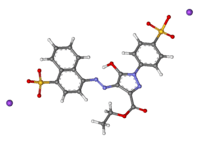Orange B
 | |
 | |
| Names | |
|---|---|
| IUPAC name
Disodium 4-[N'-[3-ethoxycarbonyl-5-oxo-1-(4-sulfonatophenyl)-4-pyrazolylidene]hydrazino]-1-naphthalenesulfonate | |
| Other names
C.I. Acid Orange 137 | |
| Identifiers | |
| 53060-70-1 | |
| 3D model (Jmol) | Interactive image |
| ChemSpider | 16735944 |
| ECHA InfoCard | 100.035.622 |
| EC Number | 239-201-5 |
| PubChem | 5362511 |
| |
| |
| Properties | |
| C22H16N4Na2O9S2 | |
| Molar mass | 590.49 g/mol |
| Except where otherwise noted, data are given for materials in their standard state (at 25 °C [77 °F], 100 kPa). | |
| | |
| Infobox references | |
Orange B is a food dye from the azo dye group. It is approved by the United States Food and Drug Administration (FDA) for use only in hot dog and sausage casings or surfaces, only up to 150 parts per million of the finished food weight.[1] It is typically prepared as a disodium salt.[1]
Orange B was first listed as an approved food dye by the FDA in 1966. In 1978, the FDA proposed removing it from the list due to concerns about the presence of carcinogenic contaminants (specifically 2-Naphthylamine). The only supplier in the United States, the William J. Stange Company, subsequently stopped manufacturing it and it was never removed from the list.[2]
References
- 1 2 "Code of Federal Regulations: Title 21, Section 74.250". U.S. Food and Drug Administration. Retrieved 24 December 2012.
- ↑ Hathcock, John N. (1982). Nutritional Toxicology. New York: Academic Press. pp. 407–408. ISBN 012332601X.
This article is issued from Wikipedia - version of the 7/7/2015. The text is available under the Creative Commons Attribution/Share Alike but additional terms may apply for the media files.